[in which we learn how to spin line flax without
a distaff]
As the weather warms up, my
fibers of choice undergo a seasonal change, away
from the woolies and toward the veggies. It seems
natural to want to spin the same fibers that
I most enjoy wearing in warm weather: cotton,
hemp, and, my personal favorite, flax. Many spinners,
even those who are quite experienced, shy away
from flax, thinking that it is complicated and
requires a distaff. Flax is actually no more
difficult to spin than wool, and even line flax
can be spun without a distaff.
Even if you have no desire
to ever plant a patch of flax, spinners will
find it helpful to understand the basic process
so you’ll know what you
are buying. Flax fiber is harvested from the
stems of the flax plant, Linum usitatissimum, an
annual that grows about two to three feet high.
Strong, silky fibers run the length of the stem,
underneath the woody outer bark. Freeing those
fibers is a time- and labor-intensive process
that requires lots of skill.
The preindustrial method
of turning flax stems into linen yarn has not
changed in centuries. Plants need to be pulled,
not cut, because the fibers extend into the
roots, and they need to be harvested at just
the right time and dried. The stems are then
rippled through a coarse metal comb to remove
the seed pods and retted (literally, rotted)
to dissolve the outer bark. Retting is a rather
stinky and tricky process and can be accomplished
by laying flax on the ground and exposing it
to the sun, dew, and rain (called “dew-retting”)
or by soaking the flax in a stream or pool of
water (“water-retting” or sometimes
more specifically “pond” or “stream-retting”).
Each method has its proponents. Ret a bit too
long and you’ll end up with a mushy mess;
underret and you won’t be able to get the
gummy sap off the fibers. After being dried again,
the fibers are then “broken” with
a huge wooden flax brake (or pounded with mallets
called beatles) and “scutched” (or “swingled”)
with a wooden knife to remove the woody outer
material. Finally, the fibers are hackled: drawn
through progressively finer metal combs to separate
the “line,” or longest fibers, from
the shorter, coarser “tow.”
The textile industry
has developed ways of mechanizing certain steps
of the process: chemicals can replace water
and dew for retting and machines can harvest,
ripple, break, and scutch. Yet the industrial
production of linen requires much more handwork
and specialized equipment than that of cotton,
and in many areas of the world, the traditional
ways are still used. Spinners who are concerned
about the environmental impact of their fiber
can look for flax retted with dew or water rather
than chemicals, although so little of the world’s
flax production is geared toward handspinners
that you may not always have a choice. For the
ultimate DIY experience, you can try growing
your own, but be sure the seeds are those of Linum
usitatissimum, which yields fiber for spinning,
and not Linum perenne, a blue-flowered
garden annual (see richters.com for seeds and
Rita Buchanan’s A Weaver’s Garden [New
York: Dover Publications, 1999]for answers to
fiber-related gardening questions you didn’t
even know you had).
I will admit that I grew
a nice large plot of flax about ten years ago,
dried the plants, and left them in my father-in-law’s shed, where
they are still waiting for me. Luckily for those
of us who take a long time to finish things,
flax does not mind being stashed in any form.
Those dried plants will be happy when I finally
ret them, and flax spinning fiber or yarn can
be stored—if kept dry—indefinitely.
Moths do not attack the cellulose fibers of flax,
so you can accumulate with abandon!
Ready-to-spin flax
is usually available as top or roving (these
terms are often used interchangeably when plant
fibers are involved), basically a combed preparation
made from shorter tow fibers, or as a strick
of line flax, the very long fibers.
Symeon
North’s
tips for wheel settings and twist for spinning
hemp top can be applied to flax as well.
(Preindustrial processing of hemp was pretty
much identical to that of flax, so if you were
able to find line hemp, you would treat it just
like line flax. Unfortunately, I have never seen
a commercial source for line hemp for handspinners,
only top.)
My favorite way to spin flax
top is to pull off a piece about six inches long,
fold it over my left index finger, move the fibers
backward in a long draw, and control twist with
my right hand. I like to make
a two-ply sport-weight from top to use in knitting.
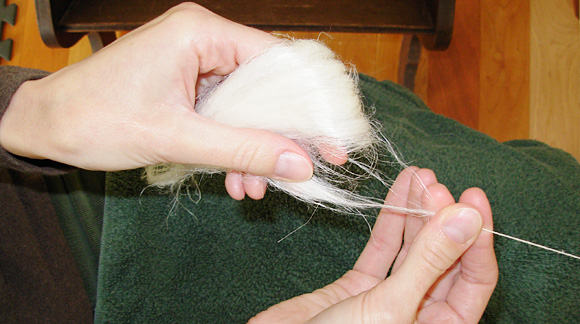
Line flax is traditionally spun from a distaff,
which is really nothing more than a way of organizing
these very long (sometimes three feet long!)
fibers and keeping them from becoming a tangled
mess. While a dressed distaff is certainly a
thing of beauty, there are numerous other ways
of taming line flax. The key thing to remember
is that a distaff organizes a quantity of flax
in a format that allows the spinner to stop spinning
and leave her set-up for later. When you are
improvising ways to spin without a distaff, you
need to think about using much smaller quantities
of fiber, and you may end up not being able to
step away from your wheel (at least, in theory!)
until you complete your handful.
Line flax usually comes twisted into a neat little
bundle with the ends wrapped around themselves.
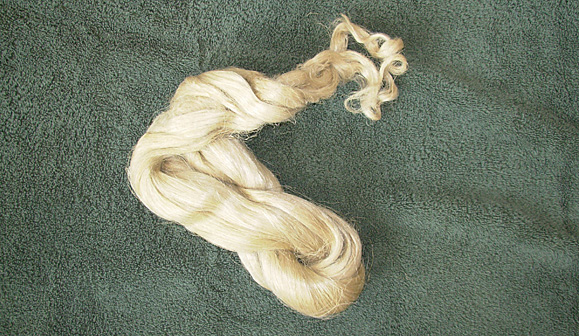
I use Euroflax
long line flax, which
is the most widely available. Carefully unwrap
the ends and untwist the bundle, gently shaking
the fibers free without tangling them.
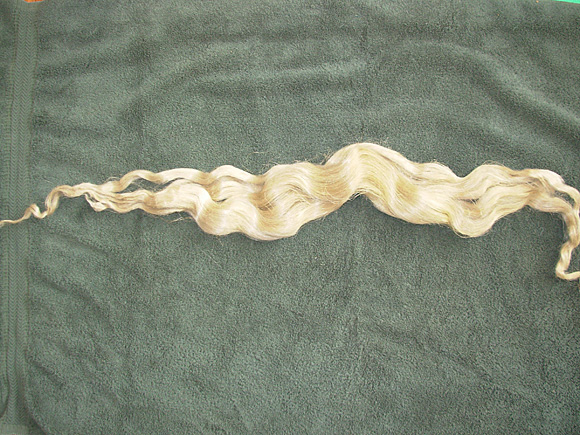
Old-timey
spinning authors tend to tell you to spin from
the “root end,” but
I’ve also seen recommendations to spin
from the “blossom end,” and after
trying each, I don’t think it makes much
of a difference. If you want to experiment, the
root end is supposed to be more crimped and a
bit coarser, while the blossom end tapers to
a point.
Set up a small table
or chair next to your wheel with a small bowl
of water on it. You’ll
need to see which side you prefer to have it
on—I like mine on the right. Of course,
spinners have argued for ages about whether flax
should be wet spun or not. I have found that
after washing and drying the finished items,
you can’t really see much of a difference,
but I prefer to dampen the fingers of my right
hand (the one closer to the orifice) regularly
as I spin anyway. I like the way the water tames
the little flyaway fibers, and wet-spun yarn
looks smoother off the bobbin. But don’t
soak the flax itself; you will end up with a
tangled mess that won’t draft. And keep
a dish towel handy for covering your lap or mopping
up drips.
In general, flax likes
to be spun finely, especially the long fibers
of line flax. To create a thicker yarn for
knitting, plan on plying. A three-ply makes
an especially nice yarn for knitting, and it’s well worth the extra work. You’ll
want to spin the singles with enough extra twist
to compensate for plying, but overtwisting will
make the finished yarn hard and brittle. Be sure
joins are secure and that the fibers actually
mesh rather than just wrapping around each other
or the yarn may drift apart when you ply it.
Loosen the take-up on your wheel if the fibers
slip out of your hands too quickly at first.
There are probably dozens
of ways to spin line flax without a distaff
but here are the four that I’ve tried.
Separate a thin (index
finger width) bunch from the strick and sit
down at your wheel. You can predraft from the
end as you would with wool top, attenuating
the strick without letting it drift into pieces.
To keep things manageable, don’t predraft too much at once. I find
that I have better luck with this method when
I limit myself to predrafting only one section
at a time. When I’ve tried to prepare several
predrafted rovings at once and then coil them,
the way I would normally prep a little basket
of wool top, I’ve ended up with too many
tangles. Create a long airy roving and begin
spinning from one end. Personally, I find that
I can’t get a good rhythm with this method
since you need to stop and predraft after finishing
each section, but I offer the idea for your experimentation.
A more satisfactory approach is to lay a towel
across your lap and, taking a half-inch wide bunch
from your strick, fan a thin layer of flax over
the towel, keeping the fibers at a right angle
to your wheel. Draw from the center of this mass
to spin.
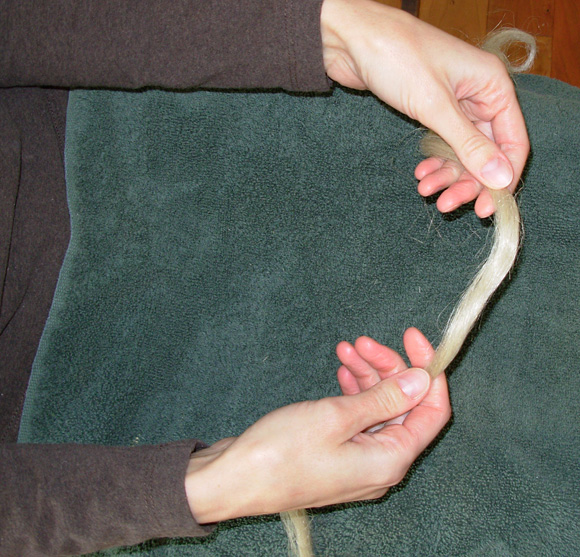
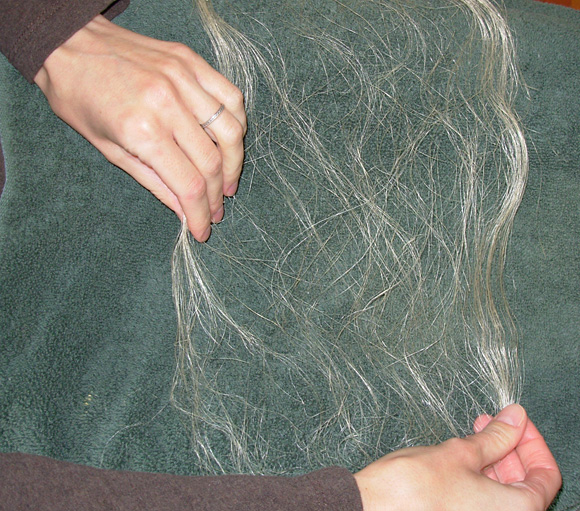
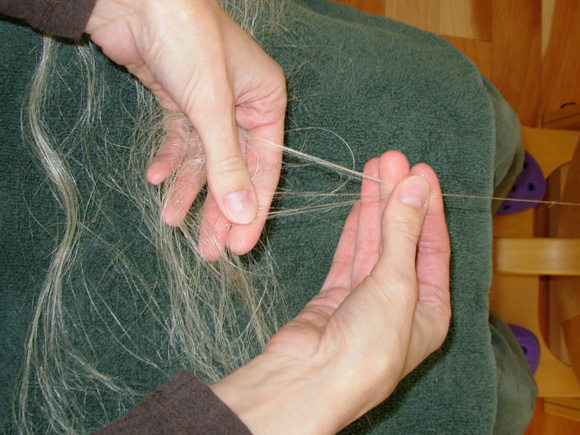
Alternately, you can fold the
little bunch of flax over your index finger and
spin from the fold. It’s a much longer
fold than you’ll have when you spin flax
roving, but it works in basically the same way.
Keep the hand holding the fiber relaxed so the
flax will draft freely.
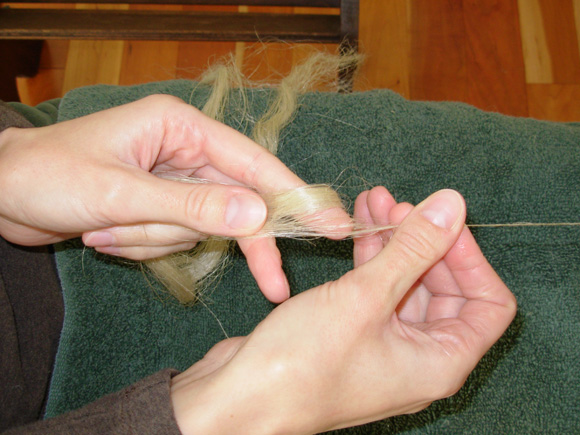
Last, but not least, you can spin line flax
from a towel. This method is generally attributed
to the venerable Olive and Harry Linder, authors
of the classic Handspinning Flax, now
out of print. This works like a charm! It also
has the advantage of being portable—you
can stop spinning at any time and fold up your
little bundle for easy transport or storage.
To begin, place a large
hand towel (or small bath towel) on a flat surface.
Uncoil your strick and gently shake it to straighten
and open the fibers. Place the fibers lengthwise
in the center of the towel with one end of the
strick visible and fold each long end of the towel
over the fibers to create a loose bundle. I prefer
not to tie the bundle.

I prefer not to tie the bundle
because I find that it prevents the fibers from
flowing freely. Place the bundle on a low table
at your side or on your lap.
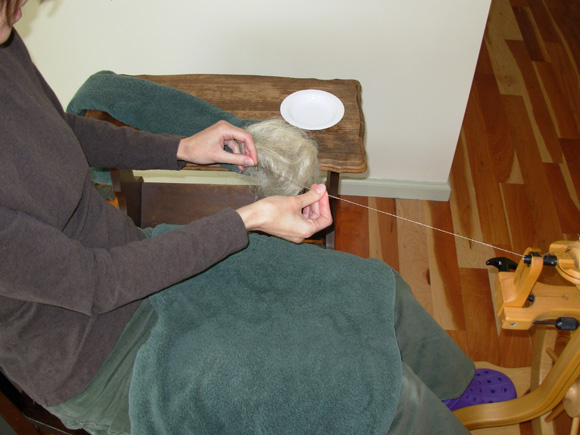
Begin by drafting a few fibers
from the end.
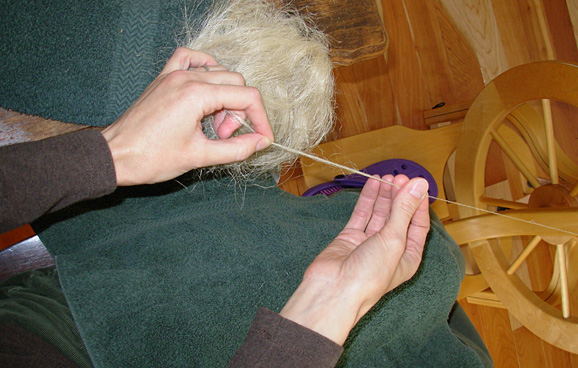
A modified short draw
comes in handy here because there isn’t much room between fiber source
and orifice. As you continue spinning, you’ll
need to reposition the strick within the towel
so that enough peeks out of the end. Eventually,
the towel will be empty and your bobbin will
be full.
Whichever method you choose, be sure to wind
your yarn off of the bobbin as soon as you are
finished filling it if you wet your fingers as
you spin. Damp linen yarn can mildew or warp
your bobbins if left to sit.
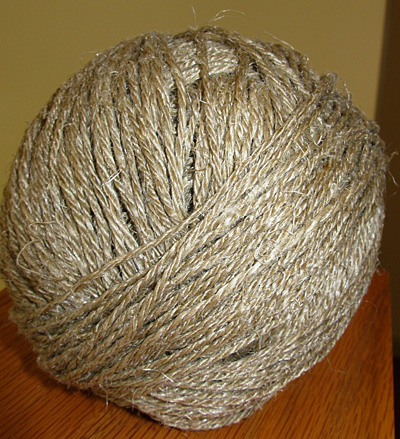  There are several options for finishing your
linen yarn. You can simply begin knitting, or
you can wash it in warm, soapy water, rinse,
and hang it to dry. Older spinning manuals often
suggest that linen yarn should be boiled on PVC
bobbins to keep it under tension, but I have
not found this to be necessary for knitting.
I prefer to boil the well-tied skeins in a big
pot of water with a little dish soap. You can
let them boil for hours without hurting them,
but fifteen minutes will work too, and then shut
off the heat. My rule of thumb is the worse the
yarn looks (or feels) right off the bobbin, the
longer I boil it! There are several options for finishing your
linen yarn. You can simply begin knitting, or
you can wash it in warm, soapy water, rinse,
and hang it to dry. Older spinning manuals often
suggest that linen yarn should be boiled on PVC
bobbins to keep it under tension, but I have
not found this to be necessary for knitting.
I prefer to boil the well-tied skeins in a big
pot of water with a little dish soap. You can
let them boil for hours without hurting them,
but fifteen minutes will work too, and then shut
off the heat. My rule of thumb is the worse the
yarn looks (or feels) right off the bobbin, the
longer I boil it!
When the water is cool, I rinse the skeins and
hang them to dry (without weights). They emerge
clean, a bit lighter, and softer, if not actually
soft. The yarn also develops a lovely shine as
it boils. Linen yarn has little elasticity and
is very stiff at first, which makes it more challenging
to knit. But completed items can be machine washed
and dried and will get softer and more lustrous
over time. Because linen has a lot of body, lace
patterns show beautifully.
When the temperature soars this summer and you
find yourself wanting to spin, give flax a try!
|

